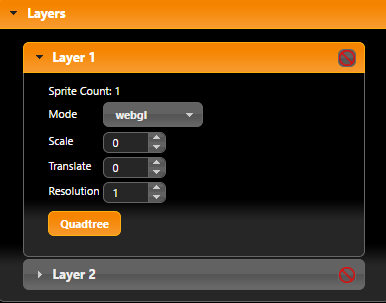Hi
If you set a layer's transform and scale to 0 in the editor (see picture below), the layer should not move when the camera moves. I've just checked and this is working correctly here, is it not working for you?

When you install this on your server, could it be that the css in that page is modifying the position of wade canvas objects?
If you want to set the layer transform and scale programmatically, you can use wade.setLayerTransform
wade.setLayerTransform(uiLayer, 0, 0); // fixed ui layer
> How i can create different scenes without wsc file?
There are several ways of doing this. You could create individual objects and add them to the scene. Alternatively you could create an object that contains all the data that a wsc file would contain. A wsc (it stands for Wade SCene) is just a plain JSON file. You can right-click it and select "Open in Code Editor" to see what's inside. Almost all the properties are optional, you only specify the ones that you need.
You call wade.importScene() and pass it an object that contains any of these properties:
- json: An array of file names, describing which json files should be loaded. This can also be an array of objects in the format {resource: string, target: string} where resource is the file to load, and the result is stored in wade.app[target].
- text: An array of file names, describing which text files should be loaded. This can also be an array of objects in the format {resource: string, target: string} where resource is the file to load, and the result is stored in wade.app[target].
- audio: An array of audio file names
- scripts: An array of script (.js) file names. Note that these scripts will be loaded and executed after the rest of the scene has been loaded, but before any scene objects are created and added to the scene
- images: An array of image file names - you don't need to include files that are referenced by the scene objects and sprites in the scene (those will be loaded automatically).
- minScreenSize: An object with x and y components describing the minimum screen size. Refer to the documentation of wade.setMinScreenSize() for more details
- maxScreenSize: An object with x and y components describing the maximum screen size. Refer to the documentation of wade.setMaxScreenSize() for more details
- windowMode: A string describing the window mode. Refer to the documentation of wade.setWindowMode() for more details
- orientation: A string describing the orientation. Valid values are 'portrait' and 'landscape', all other values are ignored. See wade.forceOrientation() for more details
- sceneObjects: An array containing all the SceneObjects to instantiate. See the SceneObject documentation for more details about the format to use
- modules: An object where the name of each property is the name of an external WADE module whose importScene is called to load the scene data described by the value of that property
- webAudioOnly: A boolean describing whether audio should only be loaded through WebAudio, and only where WebAudio is supported
- loadGlTextures: A boolean describing whether WebGl textures should be created at loading time (only applies to sprites that are on WebGl layers)
> How do template objects use code only?
I'm not quite sure what you mean by this. Do you want to create a template object in code? If so, you create a SceneObject and then call SceneObject.setAsTemplate()



